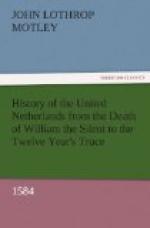Regarded as a machine for bringing the most decided political capacities into the administration of public affairs, and for organising the most practical opposition to the system of religious tyranny, the Netherland constitution was a healthy, and, for the age, an enlightened one. The officeholders, it is obvious, were not greedy for the spoils of office; for it was, unfortunately, often the case that their necessary expenses in the service of the state were not defrayed. The people raised enormous contributions for carrying on the war; but they could not afford to be extremely generous to their faithful servants.
Thus constituted was the commonwealth upon the death of William the Silent. The gloom produced by that event was tragical. Never in human history was a more poignant and universal sorrow for the death of any individual. The despair was, for a brief season, absolute; but it was soon succeeded by more lofty sentiments. It seemed, after they had laid their hero in the tomb, as though his spirit still hovered above the nation which he had loved so well, and was inspiring it with a portion of his own energy and wisdom.
Even on the very day of the murder, the Estates of Holland, then sitting at Delft, passed a resolution “to maintain the good cause, with God’s help, to the uttermost, without sparing gold or blood.” This decree was communicated to Admiral de Warmont, to Count Hohenlo, to William Lewis of Nassau, and to other commanders by land and sea. At the same time, the sixteen members—for no greater number happened to be present at the session—addressed letters to their absent colleagues, informing them of the calamity which had befallen them, summoning them at once to conference, and urging an immediate convocation of the Estates of all the Provinces in General Assembly. They also addressed strong letters of encouragement, mingled with manly condolence, upon the common affliction, to prominent military and naval commanders and civil functionaries, begging them to “bear themselves manfully and valiantly, without faltering in the least on account of the great misfortune which had occurred, or allowing themselves to be seduced by any one from the union of the States.” Among these sixteen were Van Zuylen, Van Nyvelt, the Seigneur de Warmont, the Advocate of Holland, Paul Buys, Joost de Menin, and John van Olden-Barneveldt. A noble example was thus set at once to their fellow citizens by these their representatives—a manful step taken forward in the path where Orange had so long been leading.
The next movement, after the last solemn obsequies had been rendered to the Prince was to provide for the immediate wants of his family. For the man who had gone into the revolt with almost royal revenues, left his estate so embarrassed that his carpets, tapestries, household linen— nay, even his silver spoons, and the very clothes of his wardrobe were disposed of at auction for the benefit of his creditors.




